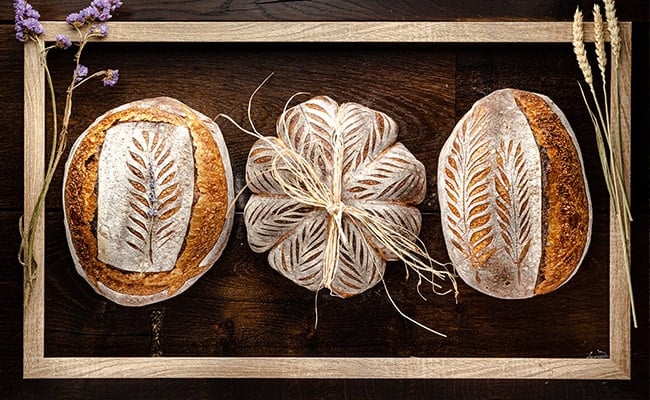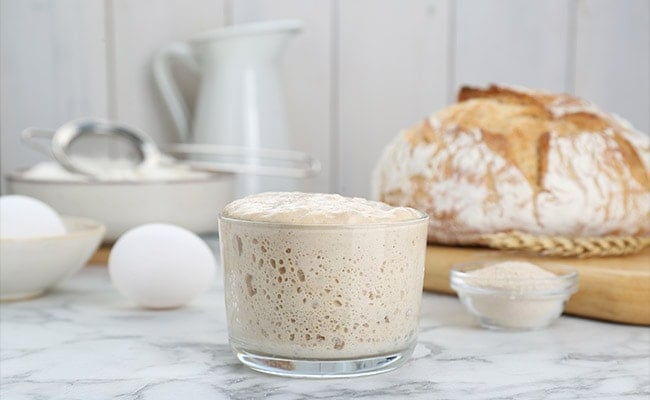How To Make Sourdough Starter For Sourdough Bread

In an age of convenience and pre-packaged foods, there’s something profoundly satisfying about creating a staple as timeless as bread from scratch. Sourdough, with its rustic charm and rich history, beckons to those seeking a connection to their culinary roots. If you’ve never ventured into the world of sourdough bread baking, here are some compelling reasons why you should give it a try. Plus, we share an easy recipe for how to make sourdough bread starter (and how to feed sourdough starter).
A Slice Of History
Sourdough is no newcomer to the world of bread-making. Its origins can be traced back thousands of years, with ancient civilizations relying on wild yeast and fermentation to leaven their bread. This time-tested tradition has been passed down through generations, making sourdough one of the most authentic and enduring bread varieties.
Simplicity At Its Finest
Baking sourdough bread doesn’t require a laundry list of ingredients or complex machinery. All you need is flour, water, salt, and a bit of patience. The magic happens when wild yeast (as opposed to commercial yeast) and lactic acid bacteria work together in a symbiotic relationship, creating a natural leavening process. This simplicity is a breath of fresh air in a world often dominated by processed foods.
A Connection To Nature
Sourdough starters are living cultures of wild yeast and bacteria. Cultivating your own starter is like having a tiny, living ecosystem in your kitchen. It requires regular feeding and care, fostering a deeper connection to the natural world and the processes that sustain life. It’s a reminder that good things take time and attention.
Superior Flavor And Nutrition
The flavor of homemade sourdough is a world apart from store-bought bread. The long fermentation process brings out complex, tangy flavors and creates a beautifully crisp crust. Furthermore, the fermentation process partially breaks down gluten and phytic acid, making sourdough easier to digest and potentially more nutritious.
Creative Expression
Sourdough bread baking is an art form in its own right. Once you’ve mastered the basics, you can experiment with various flours, hydration levels, and flavorings. Add herbs, seeds, or even dried fruits to create unique loaves that suit your taste preferences. Your kitchen becomes a canvas for culinary creativity.
A Lesson In Patience
In our fast-paced world, patience can be a rare virtue. Sourdough baking teaches us the value of waiting. From the time it takes to cultivate a robust starter to the long, slow fermentation of the dough, sourdough demands patience. But the rewards are well worth it—a sense of accomplishment and a delicious loaf to enjoy.
Joining A Community
When you bake bread you open the door to a welcoming community of likeminded enthusiasts. You can share tips, troubleshoot issues, and gain inspiration from fellow bakers through social media, forums, or local bread-making groups. It’s a wonderful way to connect with like-minded individuals who share your passion.
In a world where the art of bread making is often overshadowed by mass production, rediscovering the joy of sourdough baking is a return to simplicity, tradition, and authenticity. It’s an opportunity to nourish not only your body but also your soul. So, why not embark on this delicious journey and experience the timeless magic of sourdough bread for yourself? You’ll find that every slice carries a piece of history and a taste of the extraordinary.

how to make sourdough starter From Scratch
Ready to give it a try? Here is our step-by-step sourdough starter recipe, including how to feed sourdough starter:
Ingredients:
- 1 cup of all-purpose flour (whole wheat flour or rye flour may be used for added nutrients)
- 1 cup of lukewarm water (non-chlorinated)
Instructions:
Day 1: Initial Mixture
- In a glass or plastic container, combine 1 cup of flour with 1 cup of lukewarm water.
- Stir until it forms a thick, pancake-like batter.
- Cover the container loosely with a cloth or plastic wrap. Store your starter outside the refrigerator.
Day 2: Feed Your Starter
- After the first 24 hours, you may or may not see signs of bubbling, which is okay.
- Discard half of the mixture (about 1/2 cup) and add 1 cup of flour and 1 cup of lukewarm water
- Stir well to combine, cover, and let it sit.
Day 3: Second Feeding
- By now, you might start to see some bubbles and a slightly sour smell.
- Discard half of the mixture and again add 1 cup of flour and 1 cup of lukewarm water. Mix well and cover.

Day 4-14: Continue Feeding
- Continue the same feeding process daily, discarding half of the starter and adding 1 cup of flour and 1 cup of water.
- Over time, your starter should become more active with more bubbles and a stronger sour smell.
- By around day 7-14, it should be ready to use in sourdough bread recipes.
Maintaining Your Starter:
- Once your starter is active, you can move your starter to the fridge.
- Feed it once a week by removing it from the fridge, discarding half, and feeding it with 1/2 cup of flour and 1/2 cup of water.
Your sourdough bread starter is now ready to use in bread dough recipes. Remember, it may take a couple of weeks to fully develop the flavor and activity of your starter, so be patient and keep up with regular feedings.
Enjoy baking with your homemade sourdough starter!
Want It Even Faster?
We have partnered with Tara and Chad of She’s Rooted Home who have been making sourdough starter for 5 years.
They offer a ready-to-go Dehydrated Sourdough Starter so you can enjoy your bread 7x faster! Shop now
Frequently Asked Questions
Can I use any type of flour?
Yes, you may. I only use organic flour. You can use white, wheat, spelt or whatever you have on hand. Don’t worry about switching flours, find what works for you.
There is a layer of crust on top of my sourdough. Do I take it off?
Yes, remove the crust and feed your starter. It may just mean you need to feed your starter a little sooner between feedings.
What is the clear-brownish liquid on top of my starter?
This is called Hooch.
Does it mean my starter is bad?
No, just remove the excess liquid and feed your starter, adding a little more flour (1-2 tbsp more) than usual. This just means you may need to feed your starter twice a day.
How often do I feed my starter?
When it’s on the counter you will want to feed it 1-2 times a day., morning and night. In the cooler months, you typically only need to feed it once a day. In the summer months it’s best to feed your starter in the morning and night.
I’m unable to keep up with the daily feedings for my sourdough bread starter. How do I keep it from going bad?
Feed your starter and place it in the fridge, in a glass bowl or a mason jar, with a lid. This will put your sourdough starter in a hibernation state, allowing you to forget about it for a period of time.
How often do I need to take my sourdough starter out of the fridge to feed it?
Once a week is ideal, but honestly, I’ve gone weeks or months. Keep an eye on it and look for the clear-brown liquid forming call hooch. Remove the liquid and feed your starter.
How do I use my starter and still have some left over to keep?
Consider how much starter the recipe calls for and how much starter you currently have. If you have 1 cup of starter, and the recipe calls for 1 cup of starter, you’ll want to first feed your sourdough starter and wait a few hours. Once it has increased in volume, you can use what’s needed for the recipe and still have some left over. Preventing you from running out of sourdough bread starter.
What is leaven?
Leaven is a mixture of flour, water, and starter. Essentially it is an active starter. Some recipes will call “starter” leaven.
What does it mean when a recipe called for “active” sourdough starter?
This means that your starter was recently fed, and it has worked through the flour and water, usually causing your starter to double in size. To test if your starter is active, place a small amount in water, if it floats your starter is active.
My sourdough starter is too runny. What should I do?
Simply add 1-2 tbsp more flour to thicken it up.
My sourdough starter is too thick. What should I do?
Add 1-2 tbsp more water until you get a pancake like consistency.
What is sourdough discard?
Sourdough discard is any portion of your starter that is removed before the feeding process. For example: if you have 3 cups of starter, you can remove 2 cups as discard and continue feeding with the remaining 1 cup. There are lots of recipes like pita bread, crackers, pancakes and more that call for sourdough discard.
I’ve been following your instructions, but nothing is happening. What am I doing wrong?
The most common problem is temperature. Cold temperatures will slow the process down, whereas warmer temperatures will speed it up. Try to find a warm spot in your kitchen to keep your starter.
How many loaves of bread can I make with this sourdough starter?
Once your starter is rehydrated, you can continuously make sourdough loaves and other baked goods. You can do so long as you keep your starter culture fed and active.
Simple Sourdough Bread Recipe
Sourdough bread can quickly become overwhelming, when you first start out. This recipe was created to help simplify the process and bring about a delicious loaf, that will inspire you to continue learning and baking with your sourdough bread starter!
Ingredients:
3 cups flour
1 1/2 cups filtered water.
1/2 cup active sourdough starter
1 tsp salt
Directions:
1. Activate/feed your starter around 8:30 a.m.
2. Around 12:30 p.m. mix your ingredients (flour, filtered water, sourdough starter, and salt). Place a damp tea towel on top, and let the dough sit at room temperature for 1 hour.
3. Over the next 4 hours, you’ll preform “stretch and folds.” This will help activate the gluten, and strengthen the dough, making it easier to work with. (Note: The dough will be very sticky. It might be helpful to wet your hands, before working with the dough.) Every hour, you’ll want to scoop one side of the dough, lifting and folding it back onto itself. Stretch and fold all four sides of the dough. Let it sit for 1 hour before the next set of stretch and folds. Cover with a damp tea towel.
4. At around 5:30 p.m., you should be done with your stretch and folds. The next step is known as the bulk fermentation process. You will be placing your dough in the fridge to allow the yeast and bacteria to slowly continue to work though the dough, creating a light and airy loaf.
5. Generously flour your bread banneton (proofing basket). Place your dough into a floured banneton, cover with a plastic bag, and place in the fridge overnight.
The next day:
1. Preheat your oven to 500°F with a dutch oven inside.
2. Remove your dutch oven, from the oven. Place on your stovetop and remove the lid.
3. Remove your dough from the fridge. Gently remove your dough from the banneton, by flipping it out onto a piece of parchment paper carefully.
4. Score your loaf. Using a sharp knife or razor, make one long slice through the dough, straight down the middle.
5. Place your loaf in the dutch oven, with the parchment paper. Add the lid and bake at 500°F for 20 minutes.
6. Remove the lid to your dutch oven and drop the temperature to 450°F for approximately 20 minutes. {Note: You can add a cookie sheet underneath your dutch oven, to prevent the bottom of your crust from burning.}
7.Remove the dutch oven, from the oven and turn your oven off. Add the loaf back to the oven on a rack and crack the oven door. This will allow the loaf to cure, giving you that crispy crackle within the crust.
8. As tempting as it is, do not slice into your loaf until it’s fully cooled.
9. Enjoy!
Adding sourdough bread to your menu allows you to reap its flavorful benefits and can lead to better digestion. Baking 2-3 times a week helps maintain a happy and active starter, allowing you to bake all of your family’s favorites!
Join The Discussion
Do you have any other questions about our sourdough starter recipe?
Are you ready to bake the perfect loaf of sourdough bread?
Share your thoughts with your community here in the comments below!
This story contains product affiliate links. We may receive a commission if you make a purchase after clicking on one of these links.
Chad Philipp
Connect with Chad and Tara Philipp of She’s Rooted Home Saffron Farm, located in the Southern California Mojave Desert. She’s Rooted Home is one of the largest saffron farms in the USA.
Recognizing their Southern California desert homestead had a similar climate to Iran, the world's largest producer of saffron, Chad and Tara planted over 55K corms and harvested well over 100 grams of saffron their first year. Saffron corms take up very little space and don’t require much water or nutrition. It’s an easy plant to care for, making it a perfect addition to the kitchen garden. Chad and Tara want to educate homemakers on cooking from scratch, including the uses + benefits of herbs and spices. Helping us regain confidence & understanding of herbs & spices in the home kitchen.






Not safe to use discard before the first 7-14 days?
Rye flour or combination of AP and rye?
Wonderful knowledge! A few hundred or thousands years ago, local bakers were making bread together and they didn’t know how to read or write! 🤪😎
This is an amazing recipe write up and so detailed! One must remember that for over thousand of years ago, bakers were making bread and they didn’t follow such rigid guidelines. They didn’t know how to read or write lol! All you gotta do is really mix well water and flour, add some starter and salt and wait! Keep experimenting and encourage mistakes as we learn best from our mistakes. #baketheworldabetterplace #breadart
is there any way to make this using almond flour or any other gluten free flour?
From my research, almond flour not likely to be successful as there isn’t enough carbohydrate to feed the starter. I always recommend giving it a try! There are lots of options for flours that will work well! Experiment to find what percentage of a combination of flours might work! Best of luck to you!
This is a great starter recipe, but how do you actually use it to make bread? I’ve seen this article for a couple of years now, and would love to know how to make the bread.
Thank you.
Hi there, I have a question.
So if I feed my starter. I use it for my bread in its rise stage or do I wait for it to fall?
Also once it falls I can place in the fridge, feed once a week, use then put back in the fridge ?
Thanks for the input.
Wonderful ! Thank you !!!!
Can the throw away porrtion be used to start a new starter?
Yes – you just need to add more flour and water to your discard in a new container. There are actually a lot of great sourdough discard recipes to try as well!
I am excited to try my hand at making sour dough. Is there a way to use the throw away portion? it seems a waste to throw out. After the 7-14 days and starter is ready, is there a recipe or instructions to make the bread? I appreciate your knowledgeable feedback. Thanks Kindly
Mary
Hi! There are a lot of great uses for the “discard” sourdough – you want to look for “sourdough discard recipes” and you will find a lot of options! We are hoping to have a followup article soon on sourdough bread!